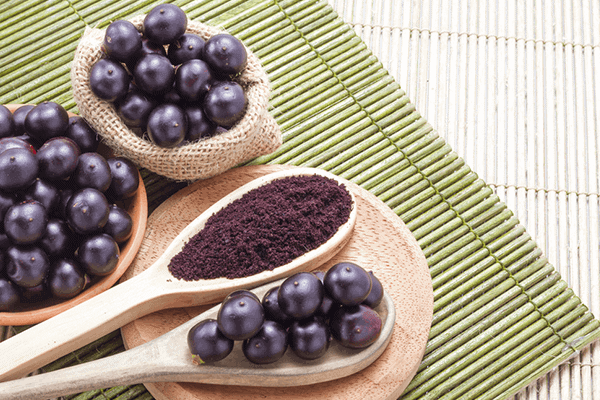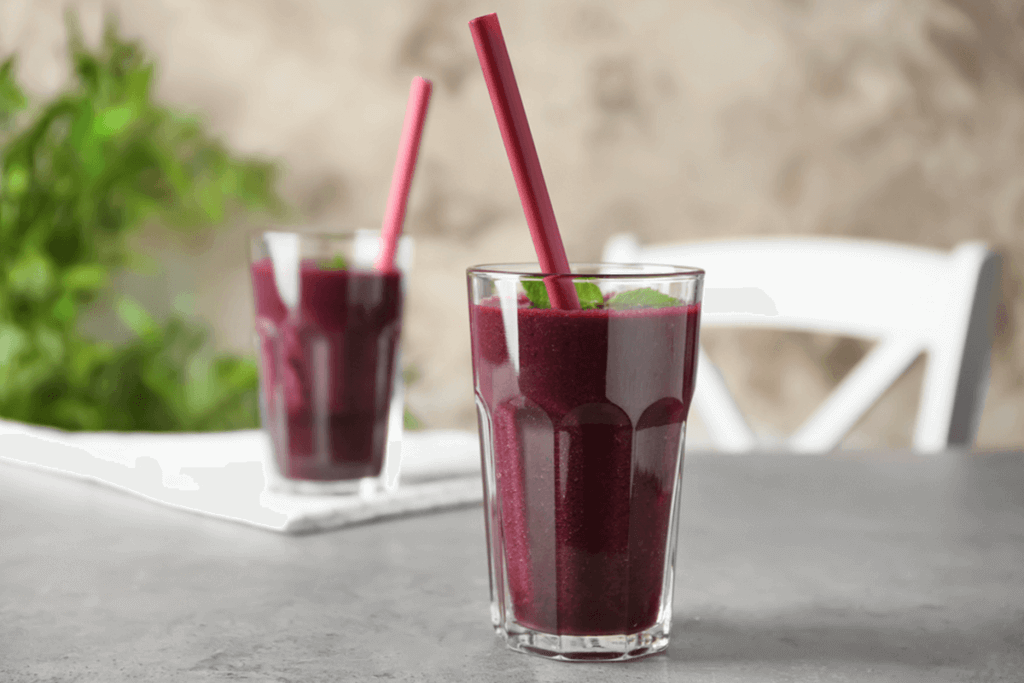What is acai?
The acai berry is the fruit of the acai palm tree (Euterpe oleracea), native to South and Central America. The acai fruit has traditionally been consumed by indigenous populations in the Amazon and is commercially available in various forms such as dried, frozen pulp, juice, powder, capsules, and tablets. (10) The acai berry contains a variety of nutrients and active components, including:- Anthocyanins
- Flavonoids
- Minerals (e.g., calcium, iron, phosphorus, potassium)
- Omega-6 and omega-9 fatty acids
- Phytosterols
- Vitamins (e.g., B1, B2, B3, C, and E) (10)

Acai health benefits
The beneficial effects of acai may be a result of anthocyanins, which exert antioxidant activity. (10) Antioxidants protect cells in the body from free radical damage. Free radicals are produced by normal processes in cells and, when elevated, are associated with oxidative stress that contributes to diseases such as atherosclerosis, diabetes, and dyslipidemia (irregular blood lipid levels, such as high cholesterol). (7)Cardiovascular health
One trial of healthy individuals assessed the effects of drinking acai juice for four weeks compared with juice from juçara, a fruit that resembles acai. The results showed that acai juice intake was associated with increased total antioxidant capacity, increased antioxidant enzyme activity, and decreased oxidative stress index. Both the acai and juçara juices were associated with an increase in the ‘good’ high-density lipoprotein (HDL) cholesterol. These findings suggest that the consumption of acai may support cardiovascular health. (2)Immune function
Polysaccharides (a type of carbohydrate or fruit sugar molecules) found in acai have been studied to assess their effect on the immune response. Experimental studies have shown that acai polysaccharides are able to modulate immune activity and stimulate certain immune cells, including T cells and myeloid cells, helping the body defend itself against harmful pathogens. There is potential for these polysaccharides to be used in conditions such as asthma and infectious diseases, however, further research is needed. (3)Inflammation
Acai may benefit individuals with inflammatory conditions such as osteoarthritis. In a twelve-week study, adults between the ages of 44 to 84 years experiencing chronic joint pain that affected range of motion were given an antioxidant-rich juice fortified with acai pulp. Juice consumption was associated with reduced pain symptoms and levels of the inflammatory marker C-reactive protein, as well as improved range of motion and engagement in daily activities. An improvement in antioxidant status was correlated with these beneficial changes to physical well-being. (4)Kidney disease
Inflammation and oxidative stress are common in chronic kidney disease (CKD), a condition characterized by kidney damage and progressive decline of kidney function. (6) Research in animals suggests that acai berry extract may improve kidney function and oxidative stress in acute renal (kidney) failure. (11) Researchers suggest that acai consumption may be a promising strategy to reduce inflammation and oxidative stress in CKD, however, studies in individuals with CKD are needed to confirm this hypothesis. (5)
Metabolic health
Acai berry may help prevent metabolic syndrome, a group of metabolic disorders characterized by excess body fat around the midsection and high blood pressure, blood sugar, and cholesterol levels. (8) In a pilot study, overweight adults consumed acai pulp twice daily for one month. Compared to baseline, intake of acai was associated with reduced metabolic disease risk markers, including lower fasting blood glucose (sugar) and insulin levels. An improvement in post-meal blood glucose response was also observed. (9)Neuroprotection
Preliminary research suggests that acai fruit may have a protective effect against seizures, depression, and mercury exposure. (1) High levels of mercury, an environmental toxin commonly found in contaminated fish and seafood, are associated with oxidative stress and DNA damage, particularly in the brain. In animal studies, acai juice has been shown to reverse the behavioral, age-related, and biochemical changes experienced following mercury exposure. (1) Although these findings are promising, more research is needed to understand the potential effects in humans.Safety considerations
A systematic review concluded that acai was not associated with adverse effects when consumed in the diet or used in medicinal amounts. There may be some safety considerations when consumed with other lipid-lowering and anti-diabetic products or medications. (10) If you’re a patient, we recommend speaking with an integrative healthcare practitioner to find out whether acai is right for you.How to get acai in your diet: try an acai smoothie bowl!
A smoothie bowl is one way to incorporate acai in its whole-food form. The ingredients are blended together and poured into a bowl, with some toppings added for flavor and texture. The smoothie consistency is similar to soft-serve ice cream, so it is typically eaten with a spoon.Smoothie ingredients
- 1 (100g) packet frozen acai pulp/puree
- 1 small banana, sliced and frozen (or substitute ½ avocado)
- 1 scoop of protein powder of choice (plain or vanilla)
- ¼ cup milk or plant-based beverage (e.g., almond, cashew, coconut)
Toppings
- 1 tbsp. unsweetened shredded coconut
- 1 tbsp. chia seeds
- ¼ cup fresh berries
The bottom line
Consuming nutrient-dense acai can increase your intake of antioxidants, vitamins, and minerals. (10) Preliminary research has demonstrated the promising effects of acai berry on health. While acai is generally safe, check with your integrative healthcare provider prior to introducing any new dietary supplements. (10)- Crespo-López, M. E., Soares, E. S., Macchi, B. . d. e. . M., Santos-Sacramento, L., Takeda, P. Y., Lopes-Araújo, A., … Arrifano, G. . d. e. . P. (2019). Towards therapeutic alternatives for mercury neurotoxicity in the Amazon: Unraveling the pre-clinical effects of the superfruit açaí (Euterpe oleracea, Mart.) as juice for human consumption. Nutrients, 11(11), 2585.
- de Liz, S., Cardoso, A. L., Copetti, C. L. K., Hinnig, P. . d. e. F., Vieira, F. G. K., da Silva, E. L., … Di Pietro, P. F. (2020). Açaí (Euterpe oleracea Mart.) and juçara (Euterpe edulis Mart.) juices improved HDL-c levels and antioxidant defense of healthy adults in a 4-week randomized cross-over study. Clinical Nutrition, S0261-5614(20), 30162–X.
- Holderness, J., Schepetkin, I. A., Freedman, B., Kirpotina, L. N., Quinn, M. T., Hedges, J. F., & Jutila, M. A. (2011). Polysaccharides isolated from açaí fruit induce innate immune responses. PLoS ONE, 6(2), e17301.
- Jensen, G. S., Ager, D. M., Redman, K. A., Mitzner, M. A., Benson, K. F., & Schauss, A. G. (2011). Pain reduction and improvement in range of motion after daily consumption of an açai (Euterpe oleracea Mart.) pulp–fortified polyphenolic-rich fruit and berry juice blend. Journal of Medicinal Food, 14(7–8), 702–711.
- Martins, I. C. V. S., Borges, N. A., Stenvinkel, P., Lindholm, B., Rogez, H., Pinheiro, M. C. N., … Mafra, D. (2018). The value of the Brazilian açai fruit as a therapeutic nutritional strategy for chronic kidney disease patients. International Urology and Nephrology, 50(12), 2207–2220.
- National Institute of Diabetes and Digestive and Kidney Diseases. (2020, July 20). Kidney disease statistics for the United States. Retrieved from https://www.niddk.nih.gov/health-information/health-statistics/kidney-disease
- Singh, R., Devi, S., & Gollen, R. (2015). Role of free radical in atherosclerosis, diabetes and dyslipidaemia: Larger-than-life. Diabetes/Metabolism Research and Reviews, 31(2), 113–126.
- Swarup, S., Goyal, A., Grigorova, Y., & Zeltser, R. (2020). Metabolic syndrome. In StatPearls . Retrieved from https://www.ncbi.nlm.nih.gov/books/NBK459248/
- Udani, J. K., Singh, B. B., Singh, V. J., & Barrett, M. L. (2011). Effects of açai (Euterpe oleracea Mart.) berry preparation on metabolic parameters in a healthy overweight population: A pilot study. Nutrition Journal, 10(1), 45.
- Ulbricht, C., Brigham, A., Burke, D., Costa, D., Giese, N., Iovin, R., … Windsor, R. (2012). An evidence-based systematic review of acai (Euterpe oleracea) by the Natural Standard Research Collaboration. Journal of Dietary Supplements, 9(2), 128–147.
- Unis, A. (2014). Açai berry extract attenuates glycerol-induced acute renal failure in rats. Renal Failure, 37(2), 310–317.





